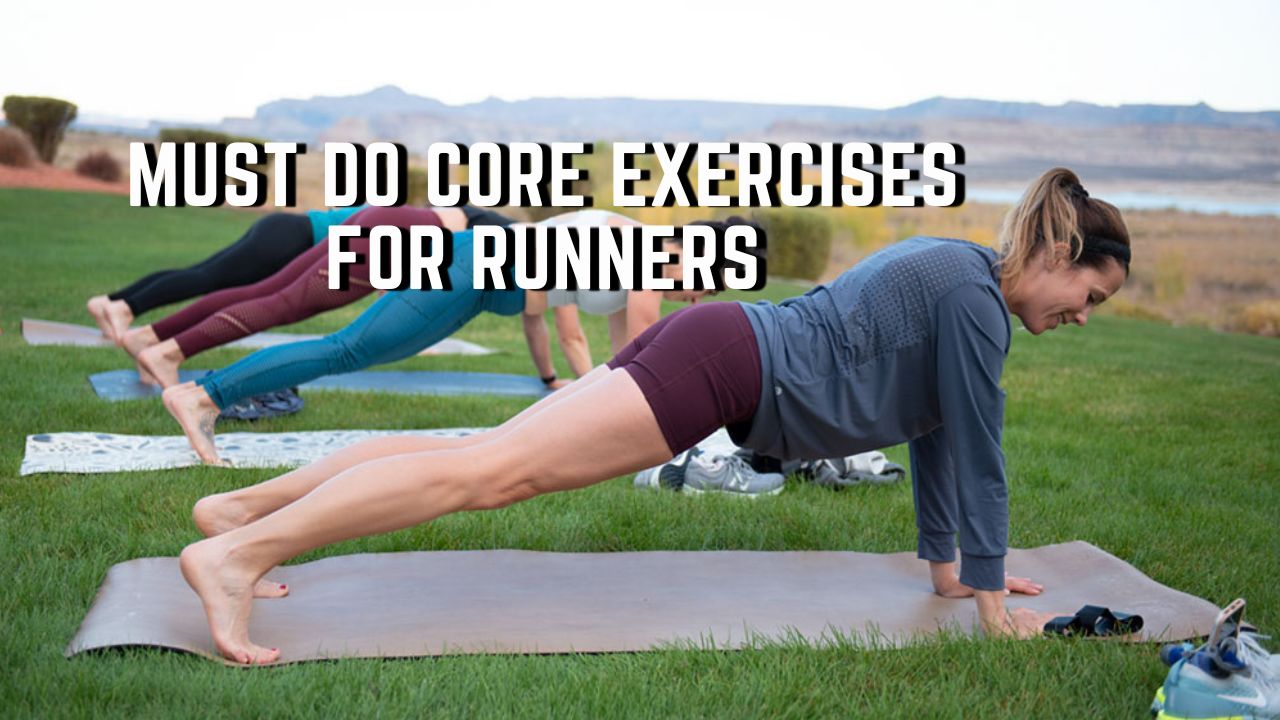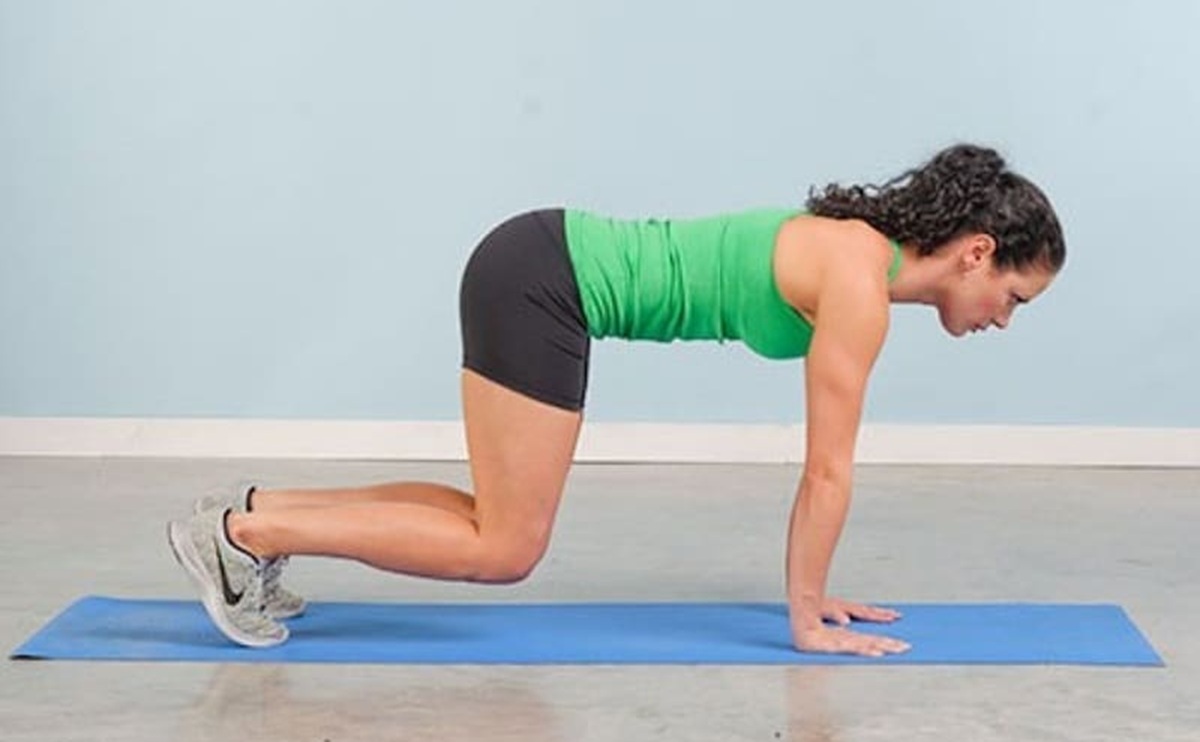Core workouts for runners are more than just a once in a while workout program; it’s movements that can improve running performance and also reduce the risk of injuries. Core workouts help stabilize your body while you run and so much more.

Unfortunately, most runners often overlook core exercises because they just aren’t sure where to begin or think that they get intimidated seeing these overcomplicated routines on social media.
As a running coach, it’s my goal to not only get you to do a dynamic warm-up, but also to start to incorporate some very basic core exercises for runners.
One of the most common reasons for running injuries is a weak core, which is to say our hips, glutes, lower back and abs. A runner core workout is about so much more than a six pack, it’s important to understand this and create a program that works.
This is a HUGE focus for me and I’m excited to help you understand why it matters for running.
- Core and abs are not the same thing.
- A strong core means better endurance, better strength and a pain free back.
- A strong core also means better posture, which can instantly make you look leaner.
✅Checkout the 30 Day Core Challenge.
10-minutes a day of movements designed specifically for runners to work the hips, abs, glutes and even throw in some mobility!
Best Core Exercises for Runners
Let’s look at my pick of some of the best core exercises for runners that you can try today. You don’t need crazy wild super complicated movements. In fact, we want ones that we can truly feel and progress by adding bands or over time start to mimic muscles we’d like to activate during the run.
Perform 2 rounds with 10 reps of each move below:
1. Plank with Leg Raise
A plank is a great exercise to start with and covers most of your core muscles. They’re especially great for runners since they focus on the engagement between your core and limbs. But I don’t like a static plank because running isn’t stationary!!
To do this, lie flat on your front and then lift up to the top of a push up, with your shoulders stacked over your wrists. Make sure you have a flat back and hold your body in a straight line from your ankles through your trunk and to your shoulders. This is the proper form for a plank position.
Now while squeezing your glutes and abs, alternating raising and lowering the right leg and then left leg just a few inches. The goal is not to let your hips dip when raising the leg.
A plank is more about the time you hold it. For a less challenging position, you can drop to your forearms till you built up your strength.
2. Knee to Elbows High Plank (Cross Body Mountain Climbers)
A variation of the classic plank position is the knee to elbows high plank. To do this, start in a full plank position and keep your abs engaged.
Then, lift your left knee and bring it forward towards your left elbow. Go back to the starting position and switch sides by now bringing the right knee to the right elbow.
Make this a slow and controlled movement, really focusing on the squeeze of your abdominals.
3. Glute Bridge March
There are a lot of glute bridge variations and learning to get in to proper position will maximize your time using them. This is one of my favorites because you’ll absolutely feel the muscles working.
Lie face up with arms extended along the body, so finger tips are touching the back of your heels.
Press full foot in to ground to raise hips up to a straight line with head. Then slowly alternate picking up the right, then left foot a few inches. As always, don’t let the hips sway or drop.
4. Deadbug
A great movement to find core weaknesses!
Lying on your back with arms straight above and knees bent to 90 degrees (think table top position). You should not have an arch in your back.
Option 1: Try to simply hold this for 2 minutes and see if you fatigue and start arching
Option 2: Keeping the right arm straight, lower it along side the head, while also straightening and lowering the left leg. This movement requires a lot of control to do it correctly! Most people fly through and miss the benefits.
Return to starting and do the opposite side.
Want a full core workout, plus ideas on how to make the deadbug harder? Checkout this core workout video!
5. Walkouts
From a standing position, roll down as though going to touch your toes. If you need to bend your knees that’s ok!
Place your hands on the ground and walk them forward to a full plank position. Engage the core and do a pushup.
Then slowly walk the hands back to your feet, keeping the legs as straight as possible. This is going to work on that hamstring flexiblity, which many runners are lacking.
Once hands are at the feet, slowly roll back up to standing. A stellar full body movement!
6. Fire Hydrants
Yet another move that everyone in my 30 Day Core Program is familiar with because it works those hips!
From a tabletop position you are going to raise your bent right knee to the side, just like you might imagine a dog peeing on a fire hydrant. It’s a slow and controlled movement.
Once you’re not letting your body tilt or sway with the movement, you can add a band above the knees for additional resistance.
7. Side Plank
This movement really works the glute medius (along with the obliques), which is a very under activated muscle. Yet of course is part of those powerhouse glutes!
Getting in to a forearm side plank, press the bottom foot in to the ground. This is press is key!!
Once you feel stable begin to raise and lower the top leg. This is going to require more focus on keeping your hips strong and high so they don’t sag during the movement.
8. Advanced Russian Twist
This is a useful core exercise, but often done incorrectly which can lead to back pain. SO only add this in if you definitely have the form correct.
Start by sitting on a mat with your knees bent at a 90-degree angle.
Root into your sit bones as you lift your feet up from the floor. Keep your knees bent while you do this. Make sure your core is engaged and your torso is upright to create a V shape with your thighs and torso.
Now extend your arms out in front of you and interlace or clasp your hands together. Using your abdominal muscles, twist to the right and then back to the center, and repeat it on the left side. That’s one rep.
To take it up a notch, you can hold a light dumbbell in your hands as you twist from side to side.
9. Better than a Superman – Low Back Pull
Your back plays a key role in holding good posture while you run, so let’s not leave it out of our core exercises.
Lying on your stomach with arms and legs extended. Contract the core and raise both arms and legs, then pull arms down as though doing a lat pull. Arms are bent to field goal posts then straightened and you lower back down.
Raising the legs helps engage that lower back, which often gets sore in newer runners.

10. Bear Plank
Think of this like your standard high plank but with a small change to where you place your feet.
Your hands should be under your shoulders, and your back is flat. They always say that while you’re in a bear plank, your back should be so flat that you could place a cup of water on your back and it doesn’t fall over.
Bring your feet in, and bend your knees similar to what it would look like for table top position. Bend your knees so that they’re at 90 degrees and under your hips.
Engage your core, tuck your hips and lift up your knees so that they’re hovering slightly above the ground.
You can make these more advanced by adding shoulder taps or a bear crawl.

Yup, it’s a number of basic movements.
You don’t need crazy wild super complicated movements. In fact, we want ones that we can truly feel and progress by adding bands or over time start to mimic muscles we’d like to activate during the run.
How Often Should Runners Do Core Workouts?
A lot. And far more than you’re probably doing!
In fact, as a running coach, I recommend doing it prior to every single run. But that means that the best core exercises will be a combination of different ones so you can mix and match.
But what’s also important is to know how to get into the proper form when doing them so that they benefit you rather than lead to an avoidable injury.
After many of the runners I worked with asked for one, I developed the 30 Day Runner Core Program! It’ll guide you through 10 minutes a day which will make all your runs better.
So, if after you’ve gone through the exercises below and want to really dive into your core training and built strength, this is a great program that’s designed for runners and will give you everything you need to perform at your best.
Because, unfortunately, as much as I love planks and they work great (more on that down below), a plank a day won’t make you a better runner or hit all the key muscles
Should I Do Core Exercises Before or After Running?
Doing core work before or after running is often a personal choice.
But here’s a breakdown of reasons why doing it around your workout is key and how it affects you before vs after your run:
- Prior to your workout it activates muscles,
- Muscle activation means they are ready to work and provide more power
- Prior to a workout means it’s part of your dynamic warm-up and you’re less likely to skip it
- Too much prior to a workout can over-fatigue the muscles, in which case why not do half before and half after
- Post-workout has fewer benefits on that run but will benefit you overall
We have a number of additional free workouts, but honestly if you want to truly see gains. You need a program that you’ll follow and do consistently!
It’s Not Too Late! Checkout the 30 Day Runner Core Program >>
Check out these workouts next:
- Strength Training Programs for Runners
- 10 minute Legs and Abs Workout
- Abs on Fire Workout
- Upper body and abs
Other ways to connect with Coach Amanda
Instagram Daily Fun: RunToTheFinish
Facebook Community Chatter: RunToTheFinish
Sign Up to Receive a Weekly Newsletter with Top Running Tips and Laughs
A few more runner core workout exercises to save for ideas later.




 New Balance Vs ASICS | Finding the Right Running Shoe
New Balance Vs ASICS | Finding the Right Running Shoe